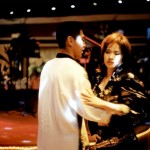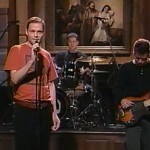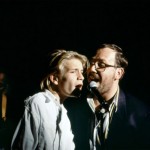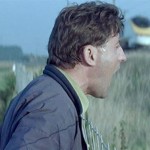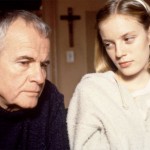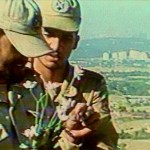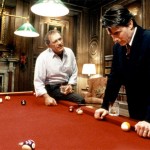Dir. by Stanley Kubrick
The following was written for a graduate seminar on James Joyce and W.B. Yeats. Please forgive the fumbling psycho-babble. I think it actually serves a very legitimate reading of this film.
– – –
Sally: You’re Bill . . . the Bill? You’re the doctor who was here last night?
Bill: Well, I suppose I am.
As Garry Leonard has recently noted, a Lacanian reading of James Joyce’s “The Dead” would describe Gabriel Conroy’s interactions with Lily, Molly Ivors, and Gretta as three attempts by the protagonist to “confirm the fictional unity of his masculine subjectivity.” His after-dinner speech, then, serves as an attempted “seduction of the Other” (Lacan’s phrase), a linguistic ploy by which Gabriel confirms his own identity by “seducing the audience into authenticating it for him.” While he is able to carefully avoid significant fragmentation during his early encounters with Lily and Miss Ivors, Gabriel is finally forced — through Gretta’s admission of her love for Michael Furey — to confront the outwardly-constructed fiction of his unified subjectivity (Leonard, 289-90). For Lacan, Gabriel’s epiphany is, in Joyce’s words, that inevitable dissolution of his “own identity . . . into a grey impalpable world” (224-25).
In Eyes Wide Shut (1999), Stanley Kubrick’s adaptation of Arthur Schnitzler’s novella, Traumnovelle (1926), Dr. Bill Harford experiences a similar dissolution, though the film essentially reverses the basic plot structure of Joyce’s story, thereby turning its focus on the terrifying consequences of that epiphany rather than its preludes (and giving us, in effect, a glimpse of the proverbial “morning after” that has intrigued readers of “The Dead” for decades). Bill’s wife, Alice, confesses in the opening act that, while on vacation, she had fantasized about abandoning her family in exchange for even one night with a naval officer who was staying in their hotel. “I was ready to give up everything,” Alice tells her disbelieving husband. “You, Helena [their daughter], my whole fucking future. Everything” (49). The admission explodes Bill’s imagined subjectivity, sending him on a dizzying odyssey through the streets of New York, where he encounters a string of Others, both women and men, with whom he attempts to recapture the unity that has suddenly become lost to him.
His search is necessarily in vain, however, as is evidenced by the film’s conclusion. Bill’s decision to “tell [Alice] everything” and Alice’s desire to “fuck . . . as soon as possible” are desperate, and ultimately unsatisfying, attempts to mask Bill’s permanently split subjectivity behind established ideological structures and jouissance. His inevitable lack of satisfaction, I will argue, is likewise experienced by the film viewer, who is presented with a story that steadfastly refuses to tie together its many loose ends. In fact, in his attempts to force “progression [and] effective closure” on the source material, Kubrick’s co-writer, Frederick Raphael, instead further exposes the futility of such an endeavor (Raphael, 119). Sean Murphy’s conclusion concerning Gabriel Conroy and “The Dead” can, I think, be likewise applied to Bill Harford and Eyes Wide Shut: “[He] will never achieve the unity that the linear narrative supposedly achieves at the end; he can never illuminate the entire beginning and middle of his consciousness via some epiphany because his subjectivity is forever split” (471).
Kubrick and Schnitzler
In 1970, Joseph Gelmis asked Stanley Kubrick why he wished to make a film about Napoleon. Fresh from his recent success with 2001: A Space Odyssey (1968), the filmmaker claimed to have found in the French leader a subject that spoke to his own fascination with history and strategy, while remaining “oddly contemporary — the responsibilities and abuses of power, the dynamics of social revolution, the relation of the individual to the state, war, milatirism, etc.” Kubrick’s Napoleon project never came to fruition. However, his answer to Gelmis’s question reveals that more than thirty years ago, the seed for Kubrick’s final film had already taken root. Napoleon’s life, he continued, “has been described as an epic poem of action. His sex life was of Arthur Schnitzler” (29). Kubrick’s obsession with Schnitzler’s short novel, Traumnovelle, was fairly well-known by those who had closely followed his career. In his recent memoir, Eyes Wide Open, Frederick Raphael recounts how his editor, Stanley Baron, and the director, Stanley Donen, both correctly guessed the source material after learning that Raphael had been hired to write for Kubrick. Donen, according to Raphael, “knew that Kubrick had been trying to ‘lick’ the Schnitzler” since at least 1972.
Set in fin-de-siecle Vienna, Traumnovelle tells the story of a young doctor, Fridolin, and his wife, Albertine, who, while attending a masked ball, are separately propositioned by strangers. The couple returns home to enjoy an unusually amorous evening, but both wake feeling troubled by the events of the previous night. “Those trivial encounters,” Schnitzler writes, “became magically and painfully interfused the treacherous illusion of missed opportunities. . . . both felt the need for mild revenge” (177). After putting their daughter to bed, Fridolin and Albertine discuss the ball and other past indiscretions: Albertine admits her lust for an officer she had noticed while vacationing on the Danish coast; Fridolin describes his brief encounter with a “young girl of no more than fifteen, her loose, flaxen hair falling over her shoulders and on one side across her tender breast” (180). Though guilty only in mind and not in body, both are disturbed by the other’s admissions. They agree, with measured assurance, to tell each other of their true feelings in the future.
Fridolin is then called away to the home of a dying patient, thus beginning the odyssey that serves as the central narrative device of both Traumnovelle and Eyes Wide Shut. His voyage leads him through a dream-like world of sexual fantasy in which he plays an increasingly active role. At each stop along the journey — his patient’s home, a young prostitute’s apartment, a costume shop, and a large country manor — Fridolin escapes without physically betraying his wife, this despite the unusually forward advances from the young women he meets along the way. The temptation, however, intensifies as he travels through increasingly unfamiliar territory. His final destination is a masked orgy, where he is exposed as an interloper and threatened with physical harm. But Fridolin is saved — or “redeemed” — by a mysterious woman who had earlier warned him of the danger. She is ushered from the room, while he is placed in a carriage and sent away.
Fridolin returns home to discover his wife lying still in bed, “her half-open lips distressingly contorted by the play of shadows: it was a face unknown to Fridolin” (237). When he bends down to touch her, Albertine explodes in a fit of dream-induced laughter. She wakes to describe the details of the dream, a dream in which she makes love to the Danish officer while Fridolin is crucified, accompanied by the sound of his wife’s mocking laughter. He determines then to discover the identity of the mysterious woman from the orgy, so as to “get even” with Albertine, “who had revealed herself through her dream for what she really was, faithless, cruel and treacherous, and whom at that point he thought he hated more profoundly than he had ever loved her” (247). His search, however, is fruitless. The next day he retraces his route from the night before, but discovers only greater ambiguities, the result of which is his gradual dissolution. “He felt helpless and inept and everything seemed to be slipping from his grasp,” Schnitzler writes; “everything was becoming increasingly unreal, even his home, his wife, his child, his profession, his very identity as he trudged on mechanically through the evening streets, turning things over in his mind” (263).
When Fridolin does finally return home, he finds on his pillow the mask that had, on the previous evening, concealed his identity at the orgy. The terrifying sight provokes “loud, heart-rending sobs” from the doctor and forces him to confess “everything” to his wife (280). After listening quietly to his story, Albertine suggests that they be grateful for having “safely emerged from these adventures — both from the real ones and from those we dreamed about.” They then doze off together, sleeping dreamlessly until the morning, when they are woken by “a triumphant sunbeam coming in between the curtains, and a child’s gay laughter from the adjacent room” (281).
The “happy” ending of Traumnovelle, however, is problematized by the sentiments expressed in Fridolin’s and Albertine’s final lines. “Neither the reality of a single night, nor even of a person’s entire life can be equated with the full truth about his innermost being,” she says. To which, he replies, “And no dream is altogether a dream.” Their reconciliation is tempered by their barely-suppressed awareness of the tenuous nature of their relationship: “Never enquire into the future,” Albertine whispers (281). They have each witnessed a frightening glimpse of the other, but have chosen — for the sake of their marriage and as a means of coping with the struggles of daily life — to ignore it. As Martin Swales says of the scene, “There is no solution — only a gratefully accepted working arrangement which is of necessity tentative and reticent in the certainties it offers” (147).
It is precisely that unsatisfying ambiguity, I would conjecture, that so fascinated Stanley Kubrick for nearly three decades. Each of his films — from his first feature, Fear and Desire (1953), an ambitious but almost laughably failed attempt to examine the two greatest motivating forces in human nature, to Full Metal Jacket (1987) — dissects socially constructed dichotomies, blurring the boundaries between good and evil, hero and villain, love and hate, fantasy and reality, us and them. Traumnovelle offered Kubrick the opportunity to observe the human animal in its most intimately guarded environment: the marriage bed. He had broached the subject in several earlier films, including Lolita (1962), Barry Lyndon (1975), and The Shining (1980), but none provided a suitably engaging subject for an extended study. Traumnovelle, however, would allow Kubrick to investigate the complex dynamics of “married sex,” as Raphael describes it, sex that is equal parts passion and domesticity — “the naked woman at the refrigerator door as she remembers to put the chicken away before she goes to bed” (43). Schnitzler’s novel negotiates that border zone where selflessness, responsibility, and commitment meet narcissism, fantasy, and desire, the product of which is a mutually reaffirming masquerade: Fridolin and Albertine ultimately return to the comfortable roles of husband/father and wife/mother, denying all that would jeopardize their performances. Or, as Leonard has noted, “one performs masques because the alternative is to have no sense of destiny at all; one wears masks to keep intact the illusion that behind them one has a real face that must be protected” (5). Traumnovelle and Eyes Wide Shut rip away those masks, and force both the characters and the readers/viewers to confront the unsettling consequences of doing so.
Lacan’s Split Consciousness
Of course, Kubrick may also have been so taken by Traumnovelle because its plot turns on “one hell of a scene.”1 Like Gretta’s in “The Dead,” Albertine’s confession provokes the story’s epiphanic moment.2 Fridolin is horrified by his wife’s secret nature, but only as it affects the fictional unity of his own subjectivity. Disoriented by his own sudden fragmentation, Fridolin is forced to begin his journey of attempted recovery. It is a moment best explained in Lacanian terms. Jacques Lacan’s brand of post-Freudian psychoanalysis problematizes consciousness by claiming that the subject is decentered and self-alienated. Instead of being whole, as Freud posits, Lacan’s ego is torn in two, inciting a life-long dance of deception. Leonard explains:
The subject is split between a narcissistic, objectlike total being (moi) and a speaking subject (je) who tries to validate this (fictional) unity of being by seducing the objective world (the Other) into declaring it authentic. Thus the moi is inherently paranoid because its existence is dependent upon, and solicitous of, outside validation. The je is controlled more than it can afford to realize because the moi exerts constant pressure upon the je to complete the moi‘s story of self-sufficient autonomy. Beyond this split subject is the Real subject of the unconscious that cannot be represented in imagery or signified in language. It is the remainder (as well as the reminder) of the lack-in-being that the moi is intended to paper over with fantasies of autonomy that constitute what it perceives as reality. (6)
Thus, only when the je fails in its task of linguistic seduction is the subject able to glimpse “the terrifying fact that the moi, the subject’s truth, which it desires to serve, is fiction” (7).
The complex series of steps in this dance is best illustrated in the masculine/ feminine relationship. For Lacan, “the Phallus” is an imagined signifier that supposedly bestows unity upon the masculine subject: he is “all” because he has designated the feminine subject as “not all.” But while the penis is a biological fact, the Phallus is merely an ideological construct born of psychic necessity. “The sexual relation,” Leonard writes, “consists of two interrelated gender myths: the myth of psychic unity and coherence that is the masculine subject and the corresponding myth of the feminine subject as the site of the otherness and absence that guarantees the supposedly self-evident unity of man” (9). Woman, as Lacan has famously formulated, is a “symptom” for the man: “what constitutes the symptom — that something which dallies with the unconscious — is that one believes in it. . . . in the life of a man, a woman is something he believes in” (168). Lacan designates this construct — this fictional woman all men must “believe in” in order to maintain their supposed unity — as “The Woman,” for the feminine subject can never be “an absolute category and guarantor of fantasy (exactly The Woman)” (Rose, 48).
Again, “The Dead” serves as a fitting example. Gabriel Conroy confidently presents himself as one who knows all that he needs to know: he is highly opinionated and imagines himself the intellectual superior of all at the party. Yet his unease is repeatedly illustrated throughout the story, as he bumbles his way through social interactions, first with Lily, then with Molly Ivors and Gretta. With Lily, for instance, Gabriel strikes the familiar pose of master/teacher to her servant/student. They engage briefly in what Leonard calls “mutually affirming dialogue” — they discuss the weather as she removes his overcoat — until he casually asks her about marriage (296). It is a mistake, a very adult question for The Woman he has constructed as a servant/child. Her world-weary answer — “The men that is now is only all palaver and what they can get out of you” — interrupts their well-rehearsed performance and threatens his imagined subjective unity. His je attempts to seduce her once more, but with little affect. “Just . . . here’s a little . . .” he stammers, as he thrusts a coin into her hand. In order to stave off further fragmentation, Gabriel escapes, “almost trotting the stairs and waving his hand to her in deprecation” (178).
Upon escaping from Lily (and later, from Miss Ivors), Gabriel finds comfort from fine-tuning his after-dinner speech, the ideal platform for the je to seduce Others into authenticating his subjective unity. But the speech is of little use when he and Gretta return to their hotel room that evening. Before leaving the party, Gabriel had paused briefly to observe his wife, who appeared lost in reverie while listening to a song. “At last she turned towards them and Gabriel saw that there was colour on her cheeks and her eyes were shining. A sudden tide of joy went leaping out of his heart” (213). That joy quickly fades, however, when Gretta reveals to her husband that it was Michael Furey, a former love, who had inspired that reverie and not Gabriel. “What is it that women want? Lacan’s answer to Freud’s most famous question is that they simply want; and the man’s desire, what he wants, is to be what he imagines they want, hence the first question” (Leonard, 303). Gabriel’s epiphany is that he is not what Gretta desires. The Woman he has constructed as “his wife” disintegrates, revealing the fiction of the role he has been performing. The story ends as he catches a horrifying glimpse of “the pitious fatuable fellow” in the mirror and is seized by a “vague terror,” before “fading out into a grey impalpable world” (222, 225).
Eyes Wide Shut
Raphael claims that, when adapting Traumnovelle for the screen, he was repeatedly encouraged by Kubrick to “just follow Arthur [Schnitzler]. . . . Track Arthur. He knows how to tell a story” (105, 91). Eyes Wide Shut remains remarkably faithful to the source material; the most significant change is its movement from turn of the century Vienna to contemporary New York. Though the move was widely criticized in the popular press — many of whom claimed that the sexual moralizing of the film seemed better suited for the Victorian era — it fits Kubrick’s modus operandi. Except for his work as a “hired gun” on Spartacus (1960), Kubrick spent his entire career in relative independence, having established himself early on as a filmmaker whose work sparked critical interest, while coming in under budget and turning a profit. The consummate businessman, Kubrick knew that a contemporary vehicle with marquee stars — whom he found in husband and wife, Tom Cruise and Nicole Kidman — guaranteed significant opening week box office returns.
Of course, Kubrick’s decision to adapt Traumnovelle to a contemporary setting was made for more than purely commercial reasons. Like Gabriel Conroy and the other protagonists of Dubliners, Bill Harford is “a central everyman character” (Walzl, 18). Raphael claims, in fact, that Kubrick envisioned his hero as “Harrison Fordish” (hence the name change from Fridolin), and forbade any reference to the Jewish elements in Schnitzler’s story (59). Harford, like his counterparts in Traumnovelle and “The Dead,” is refused a past; his condition is (we are led to believe) timeless. He is essentially Man, Husband, Father, Doctor, a position which nicely serves the central psychological question of the film: How can the masculine subject survive when all that defines it is revealed to be fiction?
The opening frames of Eyes Wide Shut firmly establish Harford’s position in the ideal masculine role. He is young, attractive, and highly successful; his status is reflected by everything with which he surrounds himself, including his beautiful wife and child, and their ridiculously opulent apartment “on Central Park West.” The first image, in fact, is of his wife, Alice, slipping her flawless body out of a black evening dress. As they prepare to attend a Christmas party, both act as if performing a well-rehearsed domestic ritual. She applies the final strokes of make-up and asks him how she looks. He replies mechanically: “You always look beautiful” (6). Lacan would explain the meaninglessness of their conversation and the performativeness of their routine as a defense mechanism, a means by which each avoids confronting his or her own identity confusion. As Leonard says of the guests at the Morkans’ party in “The Dead,” “Much of what they say to one another in conversation is compulsively banal precisely because what they cannot know is so alarming. . . . Conversation is dangerous, as Gabriel learns, because it is always an attempted seduction of the Other, and one’s sense of self may be subverted as easily as it may be confirmed” (291).
Bill Harford is made painfully aware of this danger (and its consequences) when, on the following evening, he and Alice confront each other about their behavior at the Christmas party. As in Traumnovelle, both Bill and Alice had been separately propositioned by strangers before returning home to make love. In what has become the film’s signature image, Kubrick shows us only Bill’s and Alice’s foreplay: she stands naked before their bedroom mirror, while he approaches from behind and begins to kiss her. As the camera follows in a slow zoom, Bill closes his eyes. But Alice raises hers to the mirror, looking away from her husband as if her thoughts are with someone else. When they discuss the party 24 hours later, Bill is shocked to discover what we already know: like Gabriel Conroy, Bill has been guilty of misinterpreting his wife’s desires.
Their conversation begins as the age-old and cliche-ridden debate concerning male and female sexuality. As Alice bluntly puts it, “Millions of years of evolution, right? Right? Men have to stick it in every place they can, but for women . . . women it is just about security and commitment and whatever the fuck . . . else” (46). For Bill, this simple formulation is perfectly acceptable — “A little oversimplified, Alice, but yes, something like that,” he says. However, the tenor of their argument changes considerably when Alice begins to deconstruct those preconceptions. When Alice asks accusingly, “And why haven’t you ever been jealous about me?” his je attempts to paper over the frightening ramifications of her question by systematically describing the role of The Woman that he has written for her.
Bill: Well, I don’t know, Alice. Maybe because you’re my wife, maybe because you’re the mother of my child and I know you would never be unfaithful to me.
Alice: You are very, very sure of yourself, aren’t you?
Bill: No, I’m sure of you. (47-48)
His attempted seduction of the Other fails miserably, though. Alice falls to the floor in a fit of laughter and begins the confession that completely dismantles his imagined subjective unity. By the time she finishes her soliloquy, Bill’s je has been silenced. He sits on the bed completely motionless, staring at “[his] wife . . . the mother of [his] child” as if she were a stranger.
Bill’s nocturnal odyssey through the streets of New York can be best described as a series of failed attempts by the protagonist to seduce the Other and to recapture the subjective unity that has been revealed by Alice’s confession to be fiction. In each instance, he slips on a familiar role only to discover that it is inappropriate and/or ineffective. His first stop, for instance, is at the home of a recently deceased patient. He is greeted by the patient’s daughter, Marion, and quickly establishes himself as the “consoling doctor” to her “grieving loved one” by first offering his condolences — “I’m sorry . . . I’m so sorry” — then, in a strangely rehearsed gesture, by placing his hand on the deceased’s forehead (53). But his words and gestures are lost on Marion, whose conflicted emotions are the product of her love for Harford rather than, as he incorrectly assumes, the sudden loss of her father. When she kisses him, Harford again stares ahead, motionless. The scene paradoxically serves as both a reinforcement and a refutation of his masculine subjectivity. Marion’s desire for Harford should authenticate his identity, but it fails to do so because she simultaneously exposes his failure, represented both by the presence of the body of the patient he was unable to save and by his “misdiagnosis” of Marion’s concern. This becomes a recurring theme throughout the film, as Harford repeatedly wields his Medical Board card and assures people, “I’m a doctor,” only to then fail in his attempts to comfort or save them.
Harford’s masculine subjectivity is further assaulted when he leaves Marion’s apartment. While walking through Greenwich Village, he is accosted by a group of male college students who, based on his appearance, accuse him of being a homosexual. The scene is echoed later in the film when a gay desk clerk flirts with him. As if to prove his possession of the Phallus, Harford then follows a young prostitute home, goaded on by her none-too-subtle offer to “come inside with me” (63). However, the scene — along with another that takes place soon after in the costume shop — serves only to further expose Harford’s continued failure in his attempts to recapture the fictional unity of his subjectivity. The events of the evening have rendered his je powerless, leaving him able to do little more than simply repeat the language that circulates around him. For instance, when the prostitute, Domino, asks him, “What do you wanna do?” he is unable to answer, instead placing himself totally “in [her] hands” (65). After they are interrupted by a phone call from Alice, Domino asks, “Do you have to go?” to which he is able only to respond by echoing her question, “Do I have to go? I think I do” (69). In Lacanian terms, Harford’s continued failure is inevitable. Leonard writes:
One is never so happy as when one is the triumphant hero of one’s own story, nor so desolate as when one is the suddenly vanquished hero of the other story that this same triumphant narrative left untold . . . Lacan posits that some degree of suffering might be alleviated in the human condition, but the ego itself is necessarily incurable because it papers over a lack-in-being that can be exposed or denied-but never satiated. Any sort of cure that a character in Joyce’s fiction imagines undergoing merely serves as a prelude for the next identity crisis. (7-8)
It is interesting to note that Leonard supports this claim by referring to Stephen Dedalus’s temporary victories in A Portrait of the Artist as a Young Man. His first visit to a prostitute, which marks the end of section two and presages his religious conversion in section three, is remarkably similar to Harford’s experience with Domino. While, in the film, they do not physically consummate a sexual relationship, Harford is able to symbolically complete the exchange by paying her the agreed upon amount. The small victory, however, is necessarily temporary, as he is soon back on the streets, obsessing over Alice’s imagined affair with the Naval Officer, and confronting even greater danger.
As in Traumnovelle, the final stop of Harford’s odyssey is at a mysterious masked orgy. Kubrick turns the scene into an oddly gothic ritual, more grotesque than erotic. The pivotal moment of the scene occurs when Harford is singled out as an interloper and forced to remove his mask while the other participants look on. He, like Fridolin, is then threatened with physical harm before being “redeemed” by a Mysterious Woman who had earlier warned him of danger. Schnitzler writes of the scene, “It seemed to him a thousand times worse to stand there as the only one unmasked amid a host of masks, than to suddenly stand naked among those fully dressed” (228). “The pain of shame,” Michael Sperber writes, “and the inability of the ego’s defenses (typically, avoidance and denial) to neutralize it, explain its frequent conversion to guilt” (63). Harford’s odyssey has led him to a terrifying awareness of his own fragmentation. As she is led away and he is placed in a taxi, The Mysterious Woman has, in a sense, temporarily redeemed Harford by converting his shame into the guilt that motivates his actions for the remainder of the film.
Kubrick deviates most notably from Schnitzler’s blueprint in the final act of Eyes Wide Shut, in which Harford retraces the steps of his odyssey in hopes of uncovering the identity of the Mysterious Woman. Raphael claims that he and the director often argued about how (or if) they should lend more cohesion to the story. Raphael writes:
I remained convinced that there had, for instance, to be a link between the scene at the party at the beginning of the movie and the orgy and its consequences. Otherwise there would be a catenation of events, but neither progression nor effective closure. . . . Stanley jeered at my appetite for plotted neatness, but I returned to the charge. (119)
Eyes Wide Shut includes only two significant scenes that do not exist in any form in Traumnovelle: the first occurs at the pivotal Christmas party, when Bill is ushered upstairs to find the party’s host, Ziegler, standing over a naked, overdosed prostitute; the second comes near the end of the film, when Ziegler calls Bill back to his home, ostensibly to “cut the bullshit” and to reveal “what happened last night,” thereby tying up the story’s many loose ends. The latter scene, in particular, has been the subject of considerable debate, both for its pacing (many critics have even postulated that Kubrick would have trimmed the scene had he lived) and for the unsatisfying solutions it provides. Michael Herr, Kubrick’s screenwriting collaborator on Full Metal Jacket, has written, “I don’t even know what [the scene’s] supposed to be about, unless, as I suspect, it’s really just about the red pool table” (270).
The pool table scene, for Lacan, is about the impossibility of ever truly discovering the cohesion and closure that we desire to fix on our personal narratives. In “Passing Boldly into That Other World of (W)Holes: Narrativity and Subjectivity in James Joyce’s ‘The Dead,’” Sean Murphy defines the “masculine narrative” as the typical, linear narrative that moves toward an end in order to transform “the reader in some way, namely by illuminating the beginning and the middle and thereby unveiling the ‘truth’ or ‘meaning’ inherent in the chains of signification constituting the story” (466). Murphy argues that readers of “The Dead” have forced a cohesion on Joyce’s story where none exists. “Because critics desire to symbolize their own lack,” Murphy writes:
they fall prey to Joyce’s seductive yet subversive use of the linear narrative paradigm in their readings of Gabriel and of the supposed epiphanic end of “The Dead.” Joyce’s text is seductive because it allows the reader to indulge in the fetishistic split between knowing and believing in unity and subversive because he does not provide an end, does not adhere to the law of linearity that demands an illuminative moment that makes sense of (totalizes) the fragmented discourse that precedes it. (469)
Murphy claims that the masculine narrative paradigm became popularized in the nineteenth century realistic novel and remains “the norm,” despite the invention of alternative forms by writers such as Joyce (466). Nowhere has the linear narrative maintained its grip more firmly than in the classical Hollywood cinema. In a 1987 interview, Kubrick told Jack Kroll that he wanted to “explode the narrative structure of movies,” a feat he finally accomplishes, with astonishing subtlety, in Eyes Wide Shut. The final line of the film (the other significant deviation from Traumnovelle) is ultimately unsatisfying, like the pool table scene, because it subverts our conditioned behavior as film viewers. Taught to expect pat answers and firm conclusions — particularly in an”erotic thriller,” as Warner Brothers marketed Eyes Wide Shut — Alice’s desire to “fuck” is jarring. We are left with considerable questions concerning both the happenings and consequences of Bill’s odyssey and the future of his and Alice’s relationship, questions that, despite Raphael’s best efforts, cannot be resolved. For Lacan, this ending is inevitable. Terrified by their brief glimpses of truth, Bill and Alice retreat to the familiar roles of husband/father and wife/mother so as to disguise their unity behind ideological masks. When they do fuck, it will simply be a return of jouissance, Lacan’s term for the pleasure we find in enjoying our symptoms. But that pleasure will necessarily be short-lived and unsatisfying. Like Gabriel Conroy, Bill Harford “will never achieve the unity that the linear narrative supposedly achieves at the end; he can never illuminate the entire beginning and middle of his consciousness via some epiphany because his subjectivity is forever split” (Murphy, 471).
Footnotes
1. Raphael recounts how Kubrick asked him if he thought a movie could be found in Caesar’s Gallic Wars. Kubrick says, “We wouldn’t have to change a thing. That’s one hell of a scene, so all we’d have to do is kinda . . . do it up to that point and then . . . get to the end” (76). [return]
2. Comparisons between Joyce and Schnitzler (or Joyce and Kubrick, for that matter) are purely conjectural. Richard Ellman informs us that Joyce’s Trieste library of 1920 included a 1906 edition of Schnitzler’s Lieutenant Gustl (126), and Richard Brown speculates that Joyce would have been interested in Schnitzler’s narrative experimentation, as well as the theatrical scandal that surrounded La Ronde (150). Likewise, Swales comments on the stylistic affinities shared by both men (91). It is almost certain that Kubrick would have been familiar with “The Dead.” He was widely regarded as a voracious reader and researcher. He tells Gelmis, for instance, that in preparing Napoleon, he had read “several hundred books” and seen “every film that was ever made on the subject” (30). It is highly likely, then, that while preparing A Clockwork Orange, Kubrick would have read everything written by his collaborator, Anthony Burgess, including Here Comes Everybody, which includes a brief analysis of “The Dead.” Kubrick’s own interests in narrative experimentation would also have inevitably led him to Joyce’s fiction. [return]
Works Cited
Brown, Richard. James Joyce and Sexuality. Cambridge: Cambridge UP, 1985.
Ellman, Richard. The Consciousness of Joyce. Toronto: Oxford UP, 1977.
Gelmis, Joseph. “Interview with Stanley Kubrick.” The Film Director as Superstar. Garden City: Doubleday, 1970. Rpt. in Perspectives on Stanley Kubrick. Ed. Mario Falsetto. New York: Hall, 1996. 26-47.
Herr, Michael. “Completely Miss Kubrick.” Vanity Fair Apr. 2000. 260-72.
Joyce, James. Dubliners. New York: Penguin, 1992.
Kroll, Jack. “Interview with Stanley Kubrick.” Newsweek 29 June 1987.
Kubrick, Stanley, and Frederick Raphael. Eyes Wide Shut: A Screenplay. New York: Warner, 1999.
Lacan, Jacques. Feminine Sexuality: Jacques Lacan and the Ecole Freudienne. Trans. Jacqueline Rose. New York: Norton, 1982.
Leonard, Garry. Reading Dubliners Again: A Lacanian Perspective. Syracuse: Syracuse UP, 1993.
Murphy, Sean P. “Passing Boldly into That Other World of (W)Holes: Narrativity and Subjectivity in James Joyce’s ‘The Dead.’” Studies in Short Fiction 32.3 (1995): 463-74.
Raphael, Frederick. Eyes Wide Open: A Memoir of Stanley Kubrick. New York: Ballantine, 1999.
Rose, Jacqueline. “Introduction.” Feminine Sexuality: Jacques Lacan and the Ecole Freudienne. Jacques Lacan. Trans. Jacqueline Rose. New York: Norton, 1982.
Sperber, Michael, M.D. “Shame and James Joyce’s ‘The Dead.’” Literature and Psychology 37.1 (1991): 62-71.
Swales, Martin. Arthur Schnitzler: A Critical Study. Oxford: Oxford UP, 1971.
Walzl, Florence L. “Gabriel and Michael: The Conclusion of ‘The Dead.’” James Joyce Quarterly 4.1 (1966): 17-31
Labels: American, Kubrick
